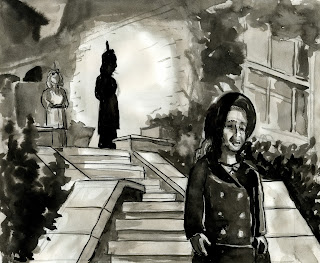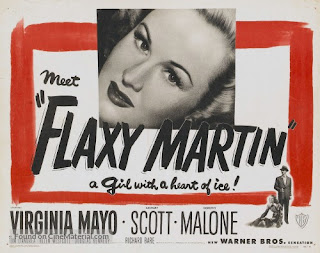Well, it's that time again. End of November means it's time to wrap up my celebration of noir by presenting some of the highlights from the films noir I watched this year. To do that, I find it fun to do hypothetical match-up of key players in those films, in contests for awards they might never have competed for in the Oscars or other annual ceremonies, due to the fact that my viewing has spanned several years worth of noir cinema. Here then, are the 2016 Noirvember Cast and Credit Awards!
My pick? Nicholas Ray for In a Lonely Place (1950)
The auteur icon here produced a confessional masterpiece, drawing emotional performance from the tough guy Bogart, and somehow maintaining not only a professional working relationship with then-wife Gloria Grahame while undergoing painful, tempestuous private separation, but collaboratively guiding her to one of her best performances ever.
Honorable Mentions;
| Byron Haskin - Too Late For Tears |
| Arthur Ripley - The Chase |
| Josef Von Sternberg, Crime & Punishment |
My pick? Richard Murphy for Cry of the City (1948)
A tough call, selecting this over the other worthy contenders. The choice came down to the tightness of the structure, and the quintessentially noir dialogue and thematic elements that the story represented.
Honorable Mentions;
Nunally Johnson - The Dark Mirror
Philip Yordan - The Chase
Alber Beich & Oscar Millard - Dead Ringer
My pick? John Alton for The Crooked Way (1949)
Another difficult decision. Gilda is such a perfect film, and Dark Mirror’s camera work does such an incredible job at blending the seems that bind Olivia DeHavilland’s dual role together, but my choice of the Crooked Way was mostly based on a combination of style and the way the many artistic flourishes of lighting and framing went beyond merely being flashy show-off moments to serving the story and bringing to light (heh) the dark (heh) subtext in the story, highlighting (heh-heh) the themes of identity, memory, and loss in visual ways.
Honorable Mentions;
Lloyd Ahern - Cry of the City
Franz Planer - The Chase
William Mellor - Too Late for Tears
Ray June - Shadow on the Wall
My pick? Max Steiner - The Man I Love (1949)
Each of these titles has great music. Gilda has some spectacular song-and-dance numbers that were star-making for Rita Hayworth. Andre Previn's score from the opening chords painted a vivid portrait of the drama to come, telling a perfect synopsis of the story before the credits ended. Dimitri Tiomkin masters a delicate balance between high drama and low humor with his score for Dark Mirror. And Alfred Newman's score, while borrowing from his own past hits, still is a perfect encapsulation of the Cry of the City. But I had to go with Steiner's work simply for the dramatic ways in which he used the popular music of tin pan alley, and especially George Gershwin, to weave a tapestry that perfectly fit the story it accompanied.
Honorable Mentions;
George Anthiel - In a Lonely Place
Andre Previn - Dead Ringer
My pick? Humphrey Bogart for In a Lonely Place (1950)
What a lineup! Richard' Conte's breakout leading man role; Glenn Ford in a role that is only dimmed by comparison to the mega-watt turn by his costar Rita Hayworth; Zachary Scott as the good man who too late finds the girl he would do anything for has played him like a rented fiddle; and Dan Duryea as a tough guy with a secret conscience that eats him alive. Only Humphrey Bogart could manage to top these, with a role that stands apart from his reliably tough, wisecracking cynic. Here he is not only an unrestrained angry beast with a bad case of road rage, but by turns arrogant and cynical, loyally over-protective, slyly suggestive, perversely provocative, urbanely witty, smitten and enamored, boyishly overeager, vindictively violent, and insanely jealous. Try wrapping all that into one package and making sense of the whole. Bogie did it.
Honorable Mentions;
Dennis O'Keefe - Woman on the Run
John Payne - the Crooked Way
Peter Lorre - Crime & Punishment
John Mills - The October Man
William Hartnell - Appointment With Crime
My pick? Ann Sheridan for Woman on the Run (1950)
Rita Hayworth's role as Gilda is beyond iconic, Olivia DeHavilland manages to keep Dark Mirror from being a gimmick film by her eminently believable sister act, Lizabeth Scott boldly subverts the role of a contented housewife, and Gloria Graham bares her soul with her slightest gestures, Ann Sheridan's role somehow stands out to me for the balanced and multifaceted delivery that defies one-dimensional characterization, more like the real human beings we know and interact with than the hollywood "types" so common (though admittedly enjoyable) in film noir. She's not merely the "wise-cracking dame," or the "tough, smart heroine," or even the "bitter wife who rediscovers her first love," but embodies all these and more in a single, congruent performance.
Honorable Mentions;
Ida Lupino - The Man I Love
Bette Davis - Dead Ringer
Ellen Drew - The Crooked Way
Virginia Mayo - Flaxy Martin
Ann Sothern - Shadow on the Wall
My pick? Edward Arnold - Crime & Punishment (1935)
I know this is the least noir of the films listed, but I really dug Arnold's role as the cop with a million tricks up his sleeve to get his man. He knows when to let the line play out, and when to reel it in, when to play dumb, and when to drop hints as to how much he really knows. But beyond being merely an inescapable symbol of law and justice, he reveals a side of grace and mercy, compassion and a desire not to merely apprehend, but to rehabilitate and restore the sense of goodness and respect to Peter Lorre's character.
Honorable Mentions;
Stephen Geray - Gilda, Woman on the Run
Victor Mature - Cry of the City
My pick? Shelley Winters for Cry of the City (1948)
Young Shelley Winters does more with the 10 minutes allotted her in this early featured role than many a leading lady is able to do with a full 90. As simple as the role may be on paper, she never lets it be one-dimensional. No mere cheap moll, this. She is a creature of flesh and blood, nuanced and breathing, an animate, believable creation. A girl in over her head by not enough that she can’t keep it on her shoulders and find a way to keep her wits about her in the midst of circumstances thrust upon her that would fluster just about anyone if it happened to them in real life. She communicates concisely all those emotions as they come to her character, and makes the role memorable despite its brevity, a glimpse of talent that was not yet fully tapped but would only shine brighter as her career developed.
Honorable Mentions;
Jeff Donnell - In a Lonely Place
Nancy Davis (Reagan) - Shadow on the Wall
My pick? Tie between Hope Emerson for Cry of the City (1949)
& Dan Duryea in Too Late For Tears (1949)
Yeah, my blog, my rules. I get to pick both. I made this category up because I love all the colorful bad guys in noir, and they're seldom the "key" roles, but they deserve to be recognized. This year these two performers both brought something interesting to the table that frankly surprised and delighted me. First - it is just so cool to find a role as unique as this lady brute that Hope Emerson embodied (yeah, not the last bad wordplay you'll see from me). She clearly relishes it, and makes it one that is impossible to forget. Watching her take Conte by the neck and squeeze, embuing her character with so much genuine, believable menace was impressive. And as for Duryea, you may watch his slapping Lizabeth Scott around in their first scene and think you're in for a typical Duryea jerk role, but stick around - he makes it interesting and unique (with some help from the script, but it is his performance that sells the part).
Honorable Mentions;
Herbert Lom - Snowbound
Sonny Tufts - The Crooked Way
Robert Alda - The Man I Love
Edward Chapman - The October Man
Barry Kroeger - Cry of the City
My pick? Jack Overman & Elisha Cook Jr. for Flaxy Martin (1949)
I know, not a full 5 picks. Last year had more to choose from in this category, but each of these thug teams is interesting in its own way. Herbert Lom and his gang are as diversely vicious as you can get, with Lom as the arch villain, Wheatley as his wry, delicate but crafty adviser, and Ivor Barnard as a bespectacled, atypical hitman. Steve Cochrane are both good in their roles, but better together for the contrast they offer- Cochrane as the brutish, reckless boss, and Lorre as the aloof but calculating underling. I ended up landing on Overman and Cook for my pick, though for their purely viceral impact. Overman is ominous as the silent killer, and Cook surprisingly resourceful and smart as the put-upon little guy who's had enough of constant put-downs and jibes at his expense. Also, he likes the word "Shamus," which I find oddly hilarious whenever he mispronounces and misuses it, as he does repeatedly in this film.
My pick? Tie between Victor Mature for Cry of the City (1948)
& Robert Keith for Woman on the Run (1950)
Again, I do what I want. I like both, I pick both. First, Robert Keith because I thought he just made a perfect copper, a smart, wise-cracking. cynic who isn't afraid to hurt people's feelings if it helps his protect lives. Second, Victor Mature for the balance and contrast he gives the Conte's character, as the man who took the other road. He represents the right choice, and he manages to do it in a way that doesn't make it seems like an easy decision. Doing the right thing is not easy, especially when you grow up in the rotten world seen in Cry of the City.
Honorable Mentions:
Don Defore - Too Late For Tears
Carl Benton Reid - In a Lonely Place
Nancy Davis - Shadow on the Wall
Robert Beatty - Appointment with Crime
Karl Malden - Dead Ringer
My pick? Cry of the City (1948)
Ok, so these picks are a largely matter of opinion and tastes, and this one’s no different. I liked this film because it is so representative of the essential elements of film noir, but it still rises above being typical, to being a standout example of the genre at its best. Others on the list stand out for the variations they play on the theme, and I could easily have chosen one of them for that very reason. This time I went with the archetypal film, because it represents classic noir in its best light (I warned you it was coming!)
So, I’m interested to hear from others who have seen these films. How does your ballot compare?
So, I’m interested to hear from others who have seen these films. How does your ballot compare?






















